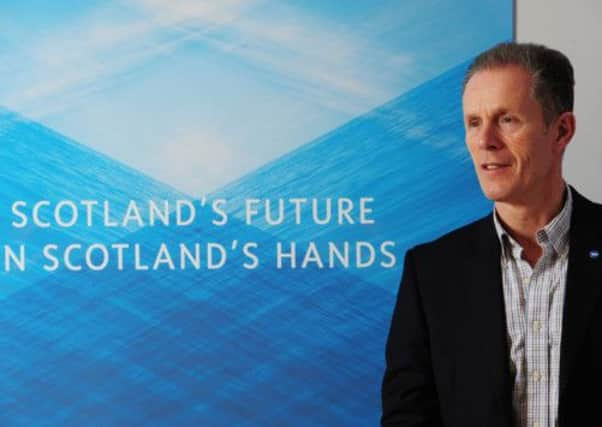Peter Duncan: Yes and No campaigns must do better


There won’t be many lazy days at the poolside over the summer for the main participants in the referendum debate. All thoughts that they might have had when their respective campaigns launched, that this July and August would be a time to recline under a Mediterranean sun, raise an unqualified toast to the year’s achievements and celebrate the certainty of forthcoming success have surely been eliminated. Or if they haven’t, they should be.
For after a year in play, both campaigns have major issues to face. Certainly, both can look back on their share of individual achievements during their first 12 months of campaigning, but both will, hopefully, understand that there is much, much more to do.
Advertisement
Hide AdAdvertisement
Hide AdFor Better Together, there will be a temptation to believe that more of the same will surely be enough to deliver the result it craves. For, after all, poll after poll has demonstrated a seemingly solid resistance to independence, and a growing confidence that its opponents will remain anchored with the support of between one-quarter and one-third of the electorate.


But, in reality, poll after poll has also demonstrated that a high proportion of Scots are firmly undecided, with a further surprisingly large segment who seem open to persuasion, or perhaps even more significantly, who have not yet thought about the referendum very much at all.
If there is one major critique of the unionist campaign, it is that is has not yet become a movement. The view taken by its early strategists that “No Scotland” was not exactly a winning theme never mind a winning name, has been proven correct, but the objective of building a movement in support of the status quo has proven beyond reach to date. A clear and widespread lack of enthusiasm for “no change” has meant that Better Together has remained a campaign, rather than a crusade woven throughout Scotland’s communities and society.
The fact is that very few people in Scotland support the current way in which Scotland is governed – too little devolution for many, too much for very few – but an alarmingly small proportion of the electorate supports the current position. That has got to be something that will give Alistair Darling’s team little cause for celebration.
The reality is that Scotland faces a very uncertain constitutional future, irrespective of the result next September. Better Together can tell people until they’re blue in the face that independence brings significant uncertainty, but it should reflect on the complete lack of clarity over what exactly Scotland will look like in the event of a No vote. And given that the momentum behind devo plus, devo more, or devo something seems to be unstoppable, with all three pro-UK parties (sensibly) proclaiming commitment to some form of additional devolution, it does seem anachronistic for the unionist camp to focus its argument on how frightening change might be. Change is coming, whatever the result, and its strategy needs to adapt to that fact, albeit belatedly.
For Yes Scotland, there is much to ponder. Senior figures inside and outside its Hope Street headquarters in Glasgow will know that there is a limited time for its current suggestion that the campaign is “all about timing” to remain credible. To an extent, they are right, it will be much more important to win the key arguments in August and September next year, than May and June this. However, foundations do need to be set down, to make those better-timed victories possible.
Foundation stones that set out the key vision for Scotland. Building blocks that start to answer the key conundrum that is emerging for Yes Scotland: why should the electorate get excited by independence, when increasingly everything looks as though it would be staying the same? And when not remaining unchanged, too many issues seem destined for the long grass. Too often, key uncertainties – European Union membership, the sterling zone, and financial sector regulation among them – have been deferred for later consideration as part of packages for post-independence negotiation.
However, more than that, there seems a fundamental lack of urgency and inspiration in the Yes Scotland campaign that will be troubling to key figures in the SNP. They will be wondering whether the big tent strategy that asked the Greens, socialists and others to join them under one campaign umbrella was the right move.
Advertisement
Hide AdAdvertisement
Hide AdAny observer of politics in Scotland over the past 20 years will have noted the relentless rise of SNP campaigning professionalism. The party has invested like few others in the technology and psephology of profiling target voters, and has shown itself to be an adept political strategist, turning a fringe pressure group into a parliamentary majority. Yet, Yes Scotland seems to be much more Tim Henman than Andy Murray when it comes to seeking out the killer passing shots in political campaigning.
It is not as though the big tent approach has delivered any great advantage for the Yes camp. When the electorate sees this battle as one between the SNP and the unionists – all the more astonishing that key aspects of campaign leadership have been effectively contracted out to an arms-length quango. Politically, this campaign could have existential consequences for the SNP, so the party would be wise to make a frank internal assessment of Yes Scotland, presumably ushering in greater direct SNP leadership of the campaign.
Any review of that campaign to date will note the ever-clearer hardening of its rhetoric to the left. Whether it is Trident, bedroom tax, or pledges to pensioners, the agenda is one of spending more and worrying less about how an independent Scotland is going to pay its way in the world.
That left-leaning campaign focus may be well researched to hit target voters who voted Labour in 2010 and then SNP in 2011, but it should allow enough time for a handbrake-turn towards the centre ground before polling day unless it wants to be seen as a rather immature and unrealistic government-in-waiting. Ultimately, a left-wing campaign is out of step with where most people in the country are, so it need to ensure it retains and builds a support base among those who want to see an entrepreneurial and successful, as well as “fair”, Scotland.
With a year of the campaign under their belts, now is the time for both campaigns to up their game, and get straight with a largely disengaged electorate. People all over the nation want to know what Scotland is going to look like under the two possible outcomes in the referendum next year. They see considerable uncertainty remaining on either side of the argument. If we are not to stumble uninformed into the biggest political decision of our lifetimes, then much more frankness is required.
We are not voting on a government for four years here; we’re voting on a country for the rest of our lives. There’s no option to change our minds after the fact. So, let’s have both sides return from the summer sun ready to set out their vision of Scotland’s future, with Nationalists telling us how the new Scotland’s place in the world will come to practical fruition, and with unionists telling us what a new, decentralised United Kingdom will deliver for Scotland. With 15 months to go, those are the only two realistic outcomes on the table, but neither is yet properly defined.
• Peter Duncan is managing director of Message Matters, a strategic communications consultancy, and a former MP